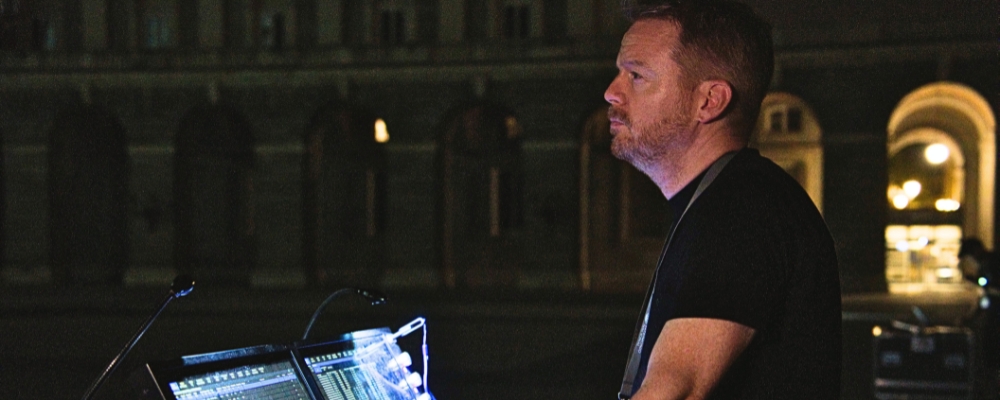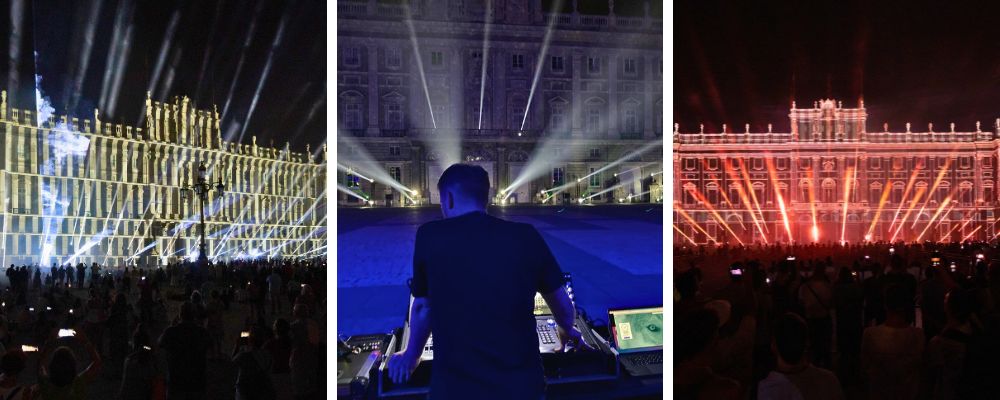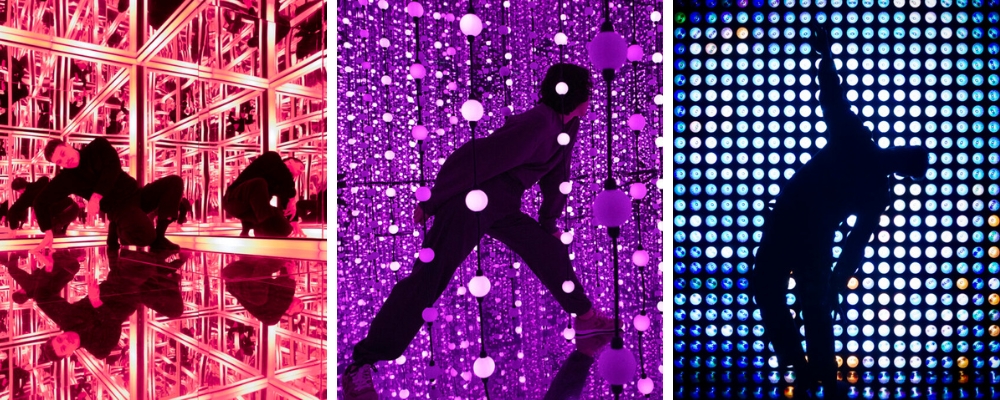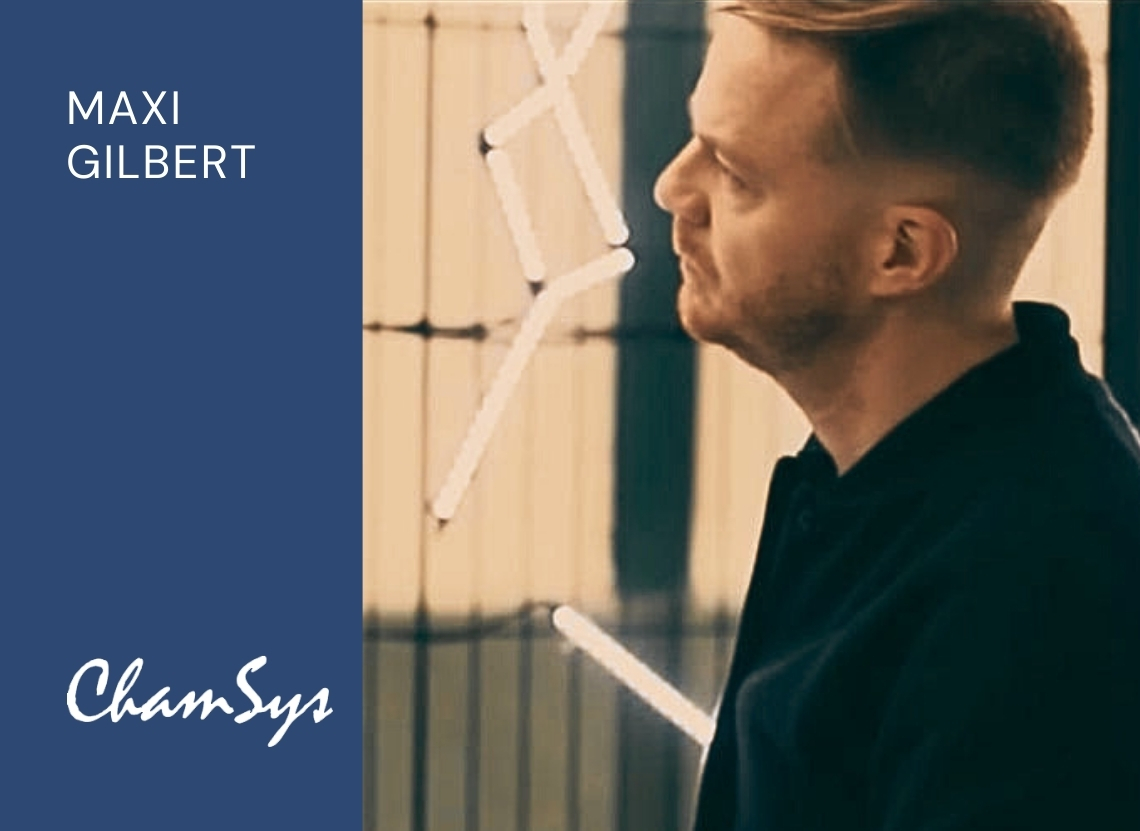Between theaters and stages, Maxi Gilbert learned to see light as his own language. Designer, scenographer, and creator of the Museum of Light in Madrid, he turned technique into visual poetry and experience into craft. His career, marked by theatrical heritage and an inexhaustible curiosity, took him from the dressing rooms of Buenos Aires to major international tours, where ChamSys consoles became key allies to materialize his artisanal hallmark: light as an instrument to tell unique stories.

Lighting designer, creator of the Museum of Light in Madrid, and a reference for a generation that sees technique as an artistic language, Maxi Gilbert has made luminaires his way of telling stories.
His precise and sensitive vision was formed at the intersection of stage, architecture, and visual emotion. More than a trade, his is a luminous vocation that took shape over time, but was born long before he could name it.
Raised among theaters, dressing rooms, and backstage, Maxi is the son of renowned actress Edda Díaz and godson of the legendary producer Lino Patalano, essential figures of the performing arts culture in Argentina. From a very young age, he understood that the magic of the show also lives behind the curtain, and in that realm, he found his place.
As a child he accompanied children’s theater tours, watching closely how the shows that later ignited the imagination of hundreds of kids were put together. “My life began in theaters. In some way, I never left them,” he would later say. That nomadic childhood, between setups and teardowns, set the rhythm of his vocation.
Today, Maxi is a lighting designer, scenographer, and production director, based in Madrid and with a unique perspective that blends technique, art, and emotion. At the helm of XLR Estudio, he has worked on operas, musicals, concerts, exhibitions, and festivals that combine technology with visual narrative. But his most symbolic and personal project is the Museum of Light, a space that proposes an immersive, sensory, and poetic experience, where light ceases to be a tool to become a language.
The First Spark
Sometimes, love for something is born with a question: what is this that I am feeling? Maxi Gilbert clearly remembers the moment something lit up inside. “I must have been seven or eight years old. We often went to the Teatro San Martín in Buenos Aires, we got press tickets because my godfather was Lino Patalano. We saw many children’s plays… but there was one in particular that marked me,” he says. It was a show by a Dutch company that worked with puppets and played intensely with light. “There I felt that there was something more. I was very influenced.”
But if there is one image that engraved itself strongly, it is that of Facundo Cabral at the Superdomo in Mar del Plata. Maxi was only nine years old. “Entering an arena with 12,000 people in silence, and seeing Cabral alone with a guitar… the only thing he had was a front light and a follow spot from behind, simulating the light of a train. It seemed incredible to me how, with so little lighting, he could captivate everyone.”
That emotional impact, more than technical, was the seed. “I liked seeing companies that did something different with lights. It wasn’t the classic comedy. When I started going to the Teatro Colón, especially with ballet, I was fascinated to see how scenography was worked with light.” The hallways of San Martín and the workshops of Colón were, literally, his school. “You saw how everything was built, how costumes were made, how each scene was treated with theatrical craftsmanship. For me, that was key: to see how theater was constructed from within.”
And on that journey, one company marked a before and after: Momix. “I loved how they worked with lights and shadows in dance. Years later, already in Spain, I ended up working with them as technical director on several tours. It was like closing a circle.”

Light as a Choice
With an actress mother and a producer godfather, many assumed Maxi Gilbert would follow in the family footsteps. “As a child they always asked me if I was going to be an actor, because I accompanied my mother everywhere: the radio, film sets… I skipped school and spent all day at ATC (Argentina Televisora Color). Mesa de Noticias was my favorite show. I was delighted,” he says. But although he enjoyed the magic of TV and was fascinated by visual production tricks, the stage never seduced him. “Anything that meant being backstage, great. But I didn’t like being on stage.”
It was that place behind the scenes that led him to choose light.
Over the years, that fascination turned into knowledge, and that knowledge into a critical eye on the evolution of the craft. “Today I notice a very marked generational difference. Many new artists don’t have theatrical culture. And young operators neither. They don’t have the background of having touched a filament, of having pulled cabling, of knowing how to set up a dimmer or how a PAR works. Many have never seen one in their lives.”
Maxi acknowledges that today there are learning tools that were not available before. But he also perceives a disconnection from the physical, real, artisanal experience. “Programming a show from the studio is great. Here we do it with Stadium Connect and Capture, I even did it for Eurovision. But it’s not the same as living it. You don’t feel the heat of the filament. You don’t see what happens when everything is assembled.”
And in that technical distance, in his opinion, there is an aesthetic loss. “Today’s shows rely on LED screens and moving lights that never stop moving. Everything is built with that style, but without depth. There’s a lack of old school. What I like least today is that everyone copies what they see, but without knowing what’s behind it.”

From Stage to Show
For Gilbert, every lighting design has to tell something. And if it doesn’t, then it’s not enough. “I always try to take everything to a more theatrical side. Even when I work with urban music artists, like Delaossa, I think of the show as a spectacle: with acts, scenes, and changes. It’s not just about turning on or off, but about creating moments.”
The upcoming show of Delaossa, which premieres on October 4, is the best example. Maxi was part of the conceptual design from the beginning. “Basically, we built a narrative. It’s not just a concert: it has its own acts. And although we work with LED, we try to make everything have that stage language.” The tour will begin in different cities in Spain and extend until 2026, with plans to cross the Atlantic. “Now I will accompany until Madrid, which is the biggest stop, and then the operator takes the rest. But in 2026 it will go to South America.”
That change of context brings other dynamics, especially technical and cultural ones. “The difference with Argentina is huge. Here it’s another thing. I left at the end of the ’90s, but the last thing I did there was with Divididos. A very experimental work. They always came to some parties I organized, like happenings, with 8mm, 16mm, and 35mm projections. And they asked me to take that on tour.”
The result was an atypical deployment for the time: slide projectors instead of video, physical effects instead of screens. And an unforgettable setup in their first Obras. “I built a scene of Temperley, with a light tower that fell in the middle of the show. There was a storm, a sprinkler system over the audience… It was incredible. And it was so hot that they even appreciated it. Today it would be impossible to do something like that.”
That’s why, whenever he can, Maxi leaves a clear message: “Whenever I have someone in front of me, I say the same thing: they have to go to the theater more, they have to see opera, they have to have their own references, not copy another group. Because what makes the difference is understanding where all this comes from.”
Luthier of Light
For Maxi Gilbert, light is not something you buy: it is something you invent. That is why, in every show, he seeks to break with the standard and design something that cannot be replicated just by opening a technical rider. “What I always try to do is integrate light into the scenography. Something more personalized, made for each artist, for each work.”
That artisanal logic has always accompanied him. In Manuel Carrasco’s last tour, for example, he decided to avoid the exclusive use of LED screens. Instead, he built frames of programmable neons spaced every 10 centimeters, covering the front and sides of the stage. “They served as both light and video. An idea that came from a fashion show I once did, where I built a sun by dismantling dryers. I asked for a 63-amp feed just for that. The heat it generated was real, you could feel it from 30 meters away. That’s when I said: this is my thing,” he recalls with a smile, an anecdote not only for him but also for the models in the show who suffered the intense heat of the scenography.
Every design has its story. And although some may call it impossible, Maxi always finds a way. “What I like is making customized fixtures. Inventing. That they can’t order it. That they have to build it.”
With smaller artists, he bets on the same: unique structures that combine functionality with theatricality. “With Vetusta Morla, for example, I created a kind of light shower over each musician with old PAR 36s, the ACLs. For the bassist, I built a structure with his amp, stand, and light. Everyone said it couldn’t be done… and we did it.”
That vision has its roots in theater. Maxi was technical director of the first International Theater Festival of Buenos Aires (FIBA) and worked with names such as Bob Wilson, Peter Brook, Sasha Waltz, or Romeo Castellucci. “There you learn that everything can come out of two hands. Castellucci asked for things like 400 kilos of sand, plastics to cover the entire stage. And for the light, a single lamp, but the right one. All that trains you to step outside the standard, outside the technical supplier, and offer something else.”
His philosophy is clear: the difference is in the details. “What I propose is never what is expected. And if they tell me it can’t be done, that makes me want to do it even more.”
Where Light Finds Its Place
Before it was a museum, it was a refuge. A space for testing, setting up, and exploration. That’s how the Museum of Light was born, in a warehouse in Madrid that Maxi Gilbert turned into a creative laboratory, without knowing that he was about to give shape to a larger project. “I set it up months before the pandemic, without knowing it. We did several streamings there, one with Drexler that was very watched in Argentina. I liked experimenting, creating installations that often remained stored away.”
The seed was technical, but the idea grew naturally. More and more people sought him out to create lighting pieces for events, exhibitions, or cultural spaces. “One day they asked me for five different installations for an event at the Reina Sofía, and that’s when I told myself: it’s logical, I have to make my own space with all this.”
The museum took shape as a personal need, but also as a response to a collective phenomenon. “People are showing a special interest in light. Like what happened with mappings, now light festivals are emerging in many cities. I’m doing the technical direction of the Madrid Light Festival, and this is part of the same thing. It had to happen.”
Today, the Museum of Light operates as an independent space, low-budget but highly ambitious. “I can’t compare myself with Berlin, of course. This is low cost, but it’s 500 square meters right in Madrid and that’s already a lot. I’d love it to be a warehouse like Matadero, but for now it is what it is. And I’m very happy.”
In addition to interactive installations, the museum opens its doors to other possibilities: product presentations, cocktails with colleagues, school visits. “We’re going to start with a didactic program for schools. Depending on the age, there will be three different manuals to explain how to work with light. It’s fun, because everything we do is interactive. And it was something I had to do, no matter what.”
ChamSys: A Path of Its Own in Lighting Programming
When Maxi Gilbert’s career began to take off internationally, the time also came to choose a tool that would give him creative independence. That’s how ChamSys came into his life. “In 2014 I started doing bigger tours and decided to buy my own console. It was through Alain Courthout that I discovered the Maxi Wing, and he sold me a used one. From that point on, my life changed quite a bit.”
Until then, Maxi’s experience was like that of many operators: adapting to whatever was available in each theater. With the Maxi Wing and ChamSys software on his own laptop, he found a new freedom. “It was all much easier. More accessible, more intuitive. In Spain there weren’t many ChamSys consoles yet, but they started to become very popular among technicians and operators because of the free software. You could build everything from home.”
The first tour he programmed with ChamSys was with Vetusta Morla, on the La Deriva tour. A before and after in the indie scene. “It was a very theatrical setup. Everything was very detailed and risky. Some people tell me they started studying lighting after watching that DVD. And a big part of that was thanks to having the Maxi Wing: it allowed me to dedicate hours and hours to programming every detail.”
Since then, Maxi has become a ChamSys reference in Spain and Latin America, and the choice was more than technical: it was aesthetic and conceptual. “They always offered me other brands, which is what everyone has, but I felt more comfortable with ChamSys. I never took a course. It’s very intuitive. And the language it has is the same I already knew from having worked with it my whole life.”
The choice of ChamSys was not a planned strategy, but a spontaneous connection. “At first it was because it seemed accessible at the time. It wasn’t even because of a salesperson or a recommendation. I had already worked with other brands, but it was with ChamSys that I felt a true empathy with the tool. And the funny thing is that I had no direct relationship with the brand… until two years ago, when Tony Cameron, the Sales Director of ChamSys, appeared.”
That natural bond consolidated over time, not through marketing or agreements, but through trust. “ChamSys allowed me to strengthen my aesthetic and scenic concepts, to have control and freedom. It was a technical choice, but also a creative one.”
And as with all relationships, they are not built on strategies, but on constant work. “Two and a half years ago, an operator who was working with the Black Eyed Peas in London wrote to me, and he had a dinner scheduled with Tony. He asked him what was happening in Spain, why so many ChamSys consoles were being sold. And he explained that it was because I was always requesting them,” Maxi admits with a smile.
That comment was the trigger. “From there, Tony contacted me, came to Madrid, we met… and it was great.”
When it comes to defining what ChamSys offers him from a technical point of view, Maxi has no doubts: “It has happened to me working with other desks in state theaters, where you have to use what they have, and I couldn’t create the effects I wanted. With ChamSys, everything is very easy and intuitive. If I want a fixture to make a cross or a spider, I have a quick shortcut to achieve it. I give it the time, the path, whatever I want. No other platform gives me that.” And he adds: “Not to mention pixel mapping. I work a lot with that, and ChamSys gives me all the tools to resolve it without complications.”
“Without a doubt, ChamSys gives you real solutions for day-to-day work,” says Maxi, who knows the system’s strengths in detail.
He also highlights the flexibility of the software in creative processes: “In the museum we have two ChamSys racks, and they work very well to control all the rooms. Many times I program in the studio with MagicPC, I send the files to the programmers, and they receive them without needing to have a physical console. That’s a huge solution for anyone who works with light.”
The accessibility of the free software is also a key point. “You don’t always need to be connected to hardware. With the demo version you can do a lot. You can have the studio at home and work seriously.”
His vision of the future is clear and direct: he aims for total integration. “For me, the ideal would be to edit video from the same desk. I’m always connected to a laser server, a video server, a visualizer… and it would be incredible to have everything integrated. For the desk to become a complete work studio.” On that horizon, where light, video, and laser coexist without intermediaries, Maxi sees the next big technical and creative leap. “We always work with the same elements. If all that could coexist in a single system, it would be the next logical step.”
On his next show with Delaossa, Maxi will work under the scenic concept proposed by the artist’s creative director, Emilio Holguín, with whom he has already collaborated on tours for Quevedo and Yung Beef. “He is someone who comes from the world of music videos and album covers, so the visual approach is very present from the start,” he explains. For this production, Maxi will operate with a ChamSys MQ500.
And although he has not officially confirmed it yet, the LD’s creative horizon continues to expand: there are outdoor installations scheduled for October and a technical proposal at the Santiago Bernabéu stadium that could make waves.

The Light That Started It All
That first round light behind Facundo Cabral was not just a childhood impression: it was a door. An image as simple as it was powerful.
Today, with all his experience, Maxi sums it up with serenity: “I’m still looking the way I looked that day. I would refine the path a little, of course, but that intuition led me to cross paths with mentors I admired from afar and who are now part of my daily life. Having gone through that school, having lived that school, was the best thing that could have happened to me.”
Although he always knew his place was in the theater, he never imagined that he would end up designing in stadiums and creating massive lighting experiences.
And as he speaks, his son —who already makes stadium models, works with Capture, and explores consoles at just eight years old— seems to be lighting his own path. Another child who, like him, once saw a light and understood that there was a whole world to discover.




